Demolition Contractors Tallmadge
Best Demo Companies in Tallmadge
Get 3 FREE Demo Contractor quotes for your project today! Compare profiles, reviews, accreditations, portfolio, etc... and choose the best offer.

Evans Landscaping
3.647 reviews4229 Round Bottom Rd., Cincinnati, 45244-1629, USAbout We know your home is your most important investment and improving curb appeal with inspired landscaping is a smart move. We can help with every step of the process, starting with design ideas—all the way through to clean-up and recycling. During the more than 30 years that we have been in business, our services have continued to grow but one thing has never changed: our commitment to quality and customer satisfaction. Whether you are planting a single tree or creating a backyard masterpiece, you’ll find that we offer superior selection, courteous service, and exceptional quality. We have the team, the knowledge, and the products to make your project a success. Working with Evans means getting the job done on time, on budget, and with truly impressive results. Call us today about materials and supplies, landscaping, demolition, site development, and excavation, or trucking and hauling. We have what you need and we can deliver it the same day.
- Services
- Why Us?
- Testimonials
- Gallery
Get Quote
High Country Excavation, LLC - Landscape Excavator Service & Demolition Excavation Contractor
57 reviewsHigh Country Excavation, LLC, Lakewood, CO, 80235, USAbout High Country Excavation, LLC High Country Excavation, LLC is a trusted local excavator in Lakewood, CO, serving residential property owners with a wide range of services beyond just excavation. We've been serving the community for over a decade, building a reputation for quality work and customer satisfaction. Our Services We specialize in a variety of excavation projects, including septic system installation, landscape excavation, site preparation, tree removal, snow removal, drainage, demolition, rock wall construction, and more. We're equipped to handle a wide range of projects, from small-scale landscaping to large-scale construction. Our Work Process We believe in optimizing our work process to ensure efficiency and cost-effectiveness. We carefully plan each project, providing realistic timelines and cost estimates. We're committed to delivering high-quality results on time and within budget.
- Services
- Why Us?
- Accreditations
- Gallery
Get Quote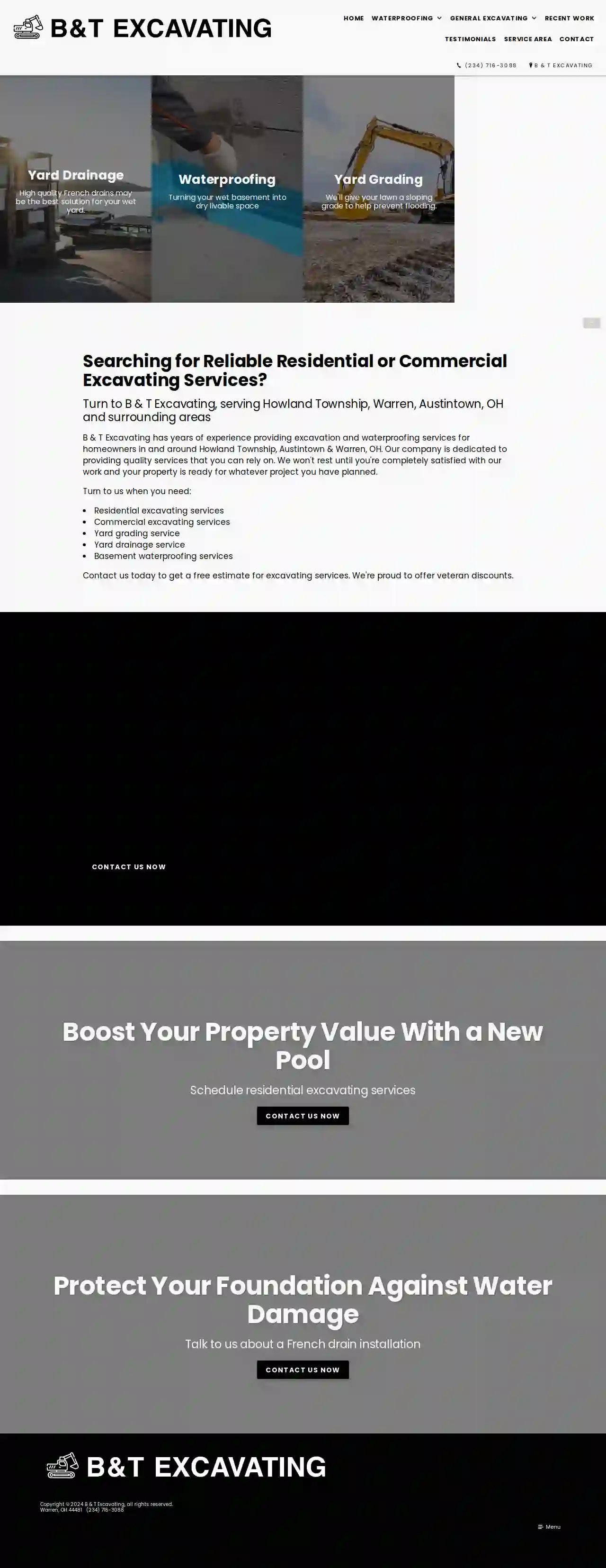
B & T Excavating
4.823 reviewsWarren, 44481, USB & T Excavating: Your Trusted Excavation Partner in Howland Township, Warren, and Austintown, OH B & T Excavating is a seasoned excavation company serving Howland Township, Warren, Austintown, and surrounding areas in Ohio. We've built a reputation for delivering high-quality excavation and waterproofing services that homeowners can rely on. Our commitment to customer satisfaction is unwavering. We won't rest until you're completely happy with our work and your property is ready for your next project. We understand that choosing the right excavation contractor is crucial for your project's success. That's why we offer a comprehensive range of services, including: Residential and Commercial Excavating Services Yard Grading Services Yard Drainage Services Basement Waterproofing Services Land Clearing Services Our team is equipped with the expertise and modern equipment to handle any excavation project, from preparing your property for new construction to installing septic systems, ponds, and pools. We're also dedicated to providing exceptional customer service and transparent communication throughout the entire process. Contact us today for a free estimate and discover how B & T Excavating can help you achieve your property goals.
- Services
- Why Us?
- Gallery
Get Quote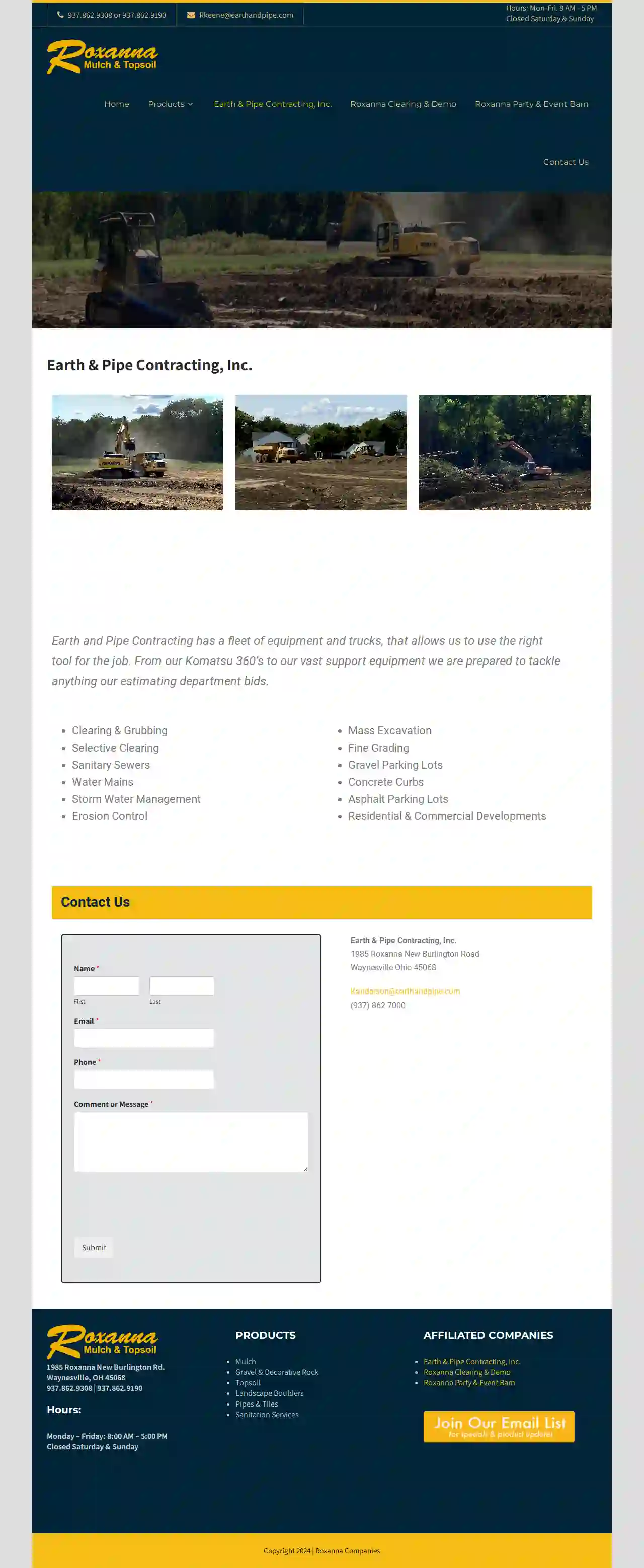
Earth & Pipe Contracting Inc
57 reviews1985 Roxanna New Burlington Road, Waynesville, 45068, USEarth & Pipe Contracting, Inc. Earth and Pipe Contracting has a fleet of equipment and trucks, that allows us to use the right tool for the job. From our Komatsu 360’s to our vast support equipment we are prepared to tackle anything our estimating department bids. Services Offered Clearing & Grubbing Selective Clearing Sanitary Sewers Water Mains Storm Water Management Erosion Control Mass Excavation Fine Grading Gravel Parking Lots Concrete Curbs Asphalt Parking Lots Residential & Commercial Developments
- Services
- Why Us?
- Gallery
Get Quote
Ferguson Construction
4.110 reviewsP.O. Box 726400, 400 Canal Street, Sidney, 45365, USBUILDING IS COMPLICATED. YOU DESERVE AN EASY BUTTON. We know the challenges and complications of commercial construction. We anticipate them and even embrace them. Our “easy button” approach simplifies the entire process while reducing uncertainty and miscommunication, giving businesses the positive experience they deserve. EXPLORE OUR EASY BUTTON ON APPROACH
- Services
- Why Us?
- Accreditations
- Testimonials
- Gallery
Get Quote
Mike Pusateri Excavating
4.85 reviews16363 Saint Clair Avenue, East Liverpool, 43920, USA Family Owned Commercial and Residential Excavating Company Mike Pusateri Excavating Inc is a Commercial and Residential Excavating Company that prides itself in the quality of work and high standards of performance it provides for our customers. These qualities and principles have been the foundation of the company since 1960. We continue to take pride in our work and strive for excellence resulting in top quality projects that reflects the reputation we have built over the years and continue to stand by. The Company was founded by Michael Pusateri Sr. in 1960. It all started with a dump truck and high lift. The company continued to grow due to the hard work and success over the years. Eventually, the reins were turned over to the next generation when Mike Pusateri Jr and brother Jim Pusateri took over the responsibilities. During these years the company began to expand, and their equipment fleet and capabilities grew larger. Mike Pusateri Jr. is still the acting President of the company and now with the addition of a third generation to include sons Matt and Jason Pusateri as well as nephew Adam Pusateri, the company continues to grow maintaining the reputation it was built upon. The fleet now has GPS modeling and machine control capabilities and are continually evolving to provide High Quality Projects.
- Services
- Why Us?
- Our Team
- Gallery
Get Quote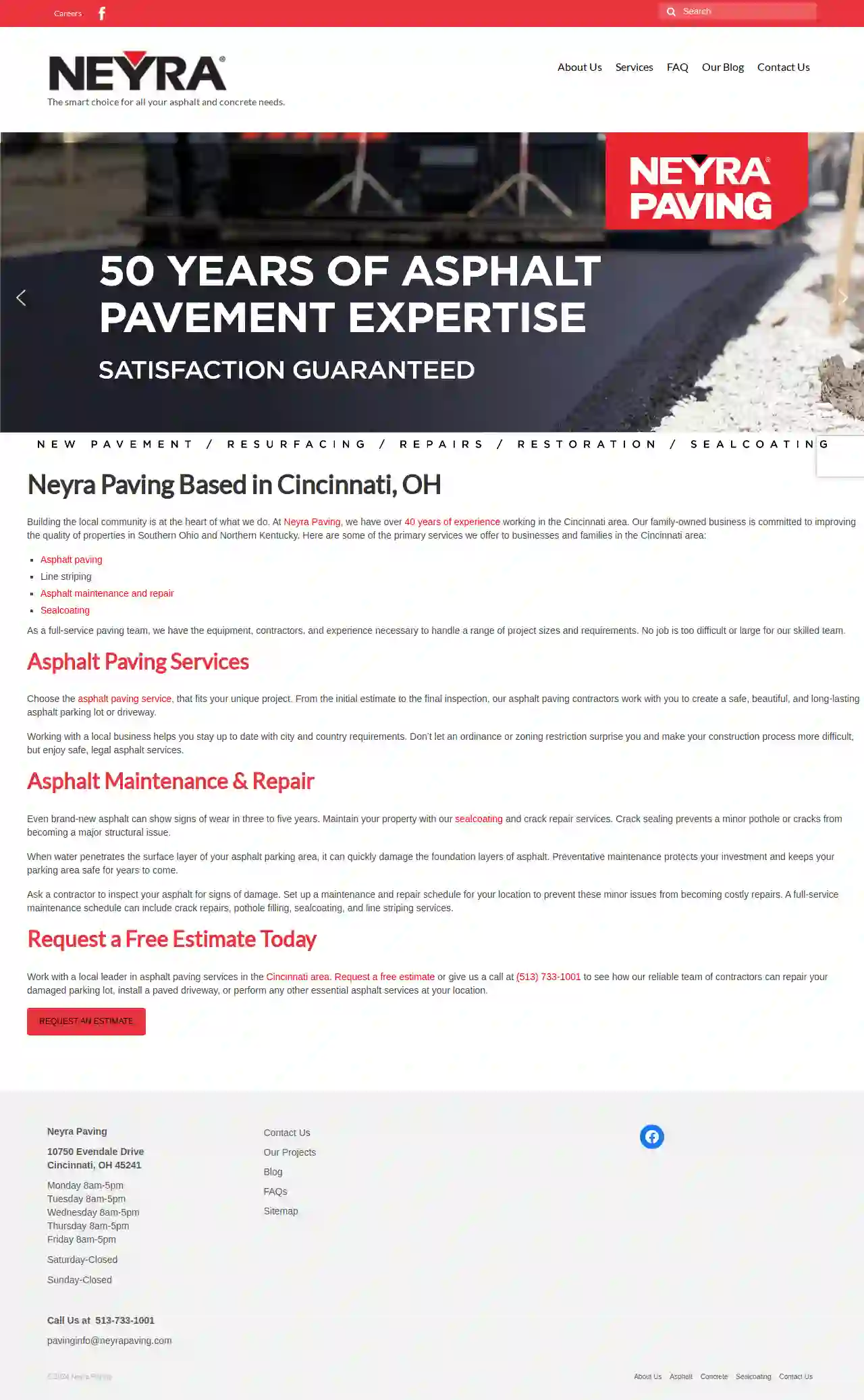
Neyra Paving
4.19 reviews10750 Evendale Drive, Cincinnati, 45241, USAbout Neyra Paving Neyra Paving is a family-owned business with over 40 years of experience serving the Cincinnati area. We are dedicated to providing high-quality asphalt and concrete paving and repair services to businesses and families in Southern Ohio and Northern Kentucky. Our commitment to quality craftsmanship and superior customer service is evident in every project we undertake, no matter how big or small. We understand that building the local community is at the heart of what we do. That's why we strive to provide our clients with the best possible experience, from the initial estimate to the final inspection. We are committed to working with you to create a safe, beautiful, and long-lasting asphalt parking lot or driveway. As a full-service paving team, we have the equipment, contractors, and experience necessary to handle a range of project sizes and requirements. No job is too difficult or large for our skilled team.
- Services
- Why Us?
- Gallery
Get Quote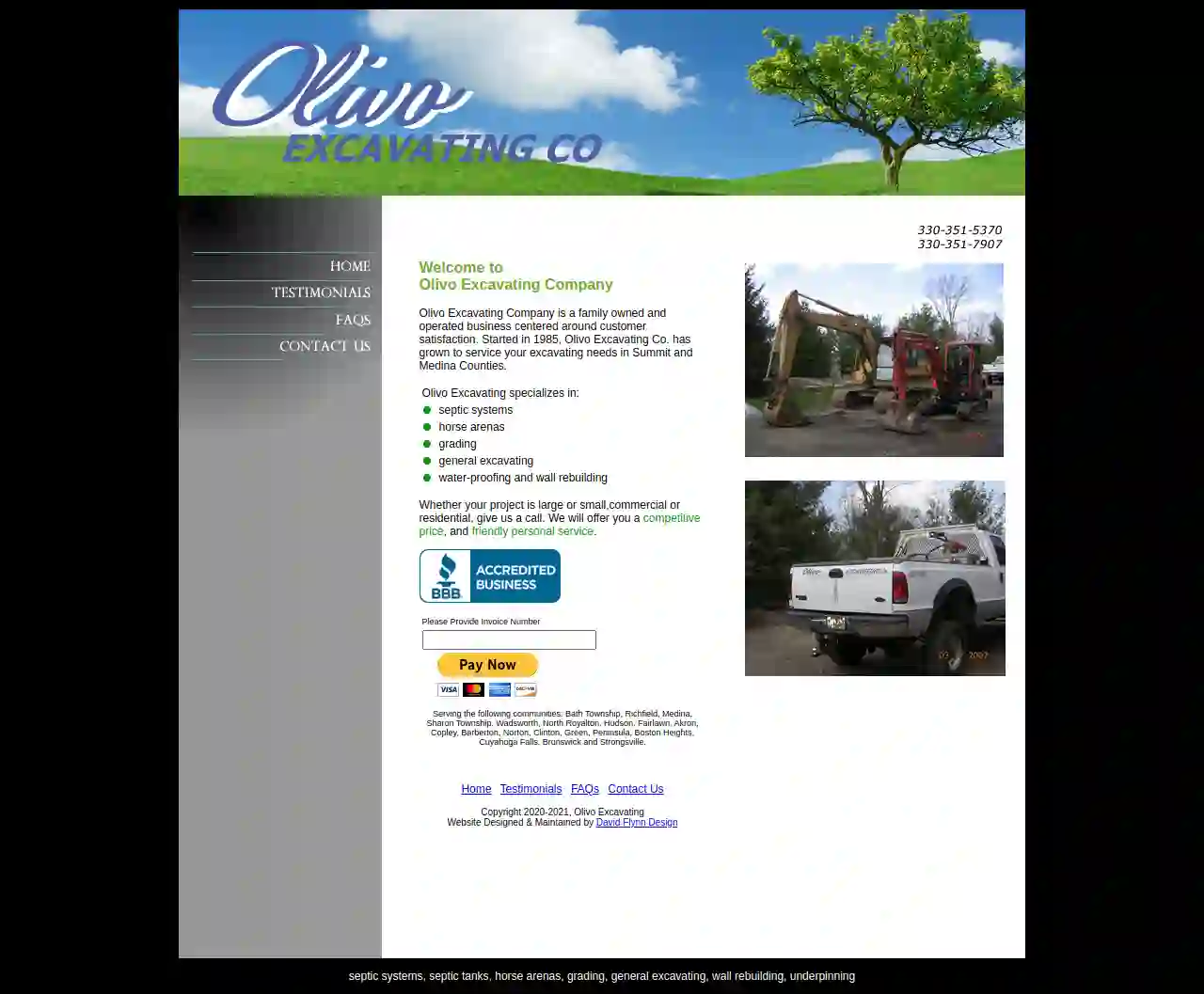
Olivo Excavating Co
4.834 reviewsAkron, USAbout Olivo Excavating Company Olivo Excavating Company is a family-owned and operated business deeply committed to customer satisfaction. Established in 1985, Olivo Excavating Co. has expanded its services to meet the excavating needs of clients in Summit and Medina Counties. We specialize in a wide range of excavating services, including: Septic Systems Horse Arenas Grading General Excavating Waterproofing and Wall Rebuilding Whether your project is large or small, commercial or residential, we invite you to contact us. We are dedicated to providing competitive pricing and friendly, personalized service. We proudly serve the following communities: Bath Township, Richfield, Medina, Sharon Township, Wadsworth, North Royalton, Hudson, Fairlawn, Akron, Copley, Barberton, Norton, Clinton, Green, Peninsula, Boston Heights, Cuyahoga Falls, Brunswick, and Strongsville.
- Services
- Why Us?
- Testimonials
- Gallery
Get Quote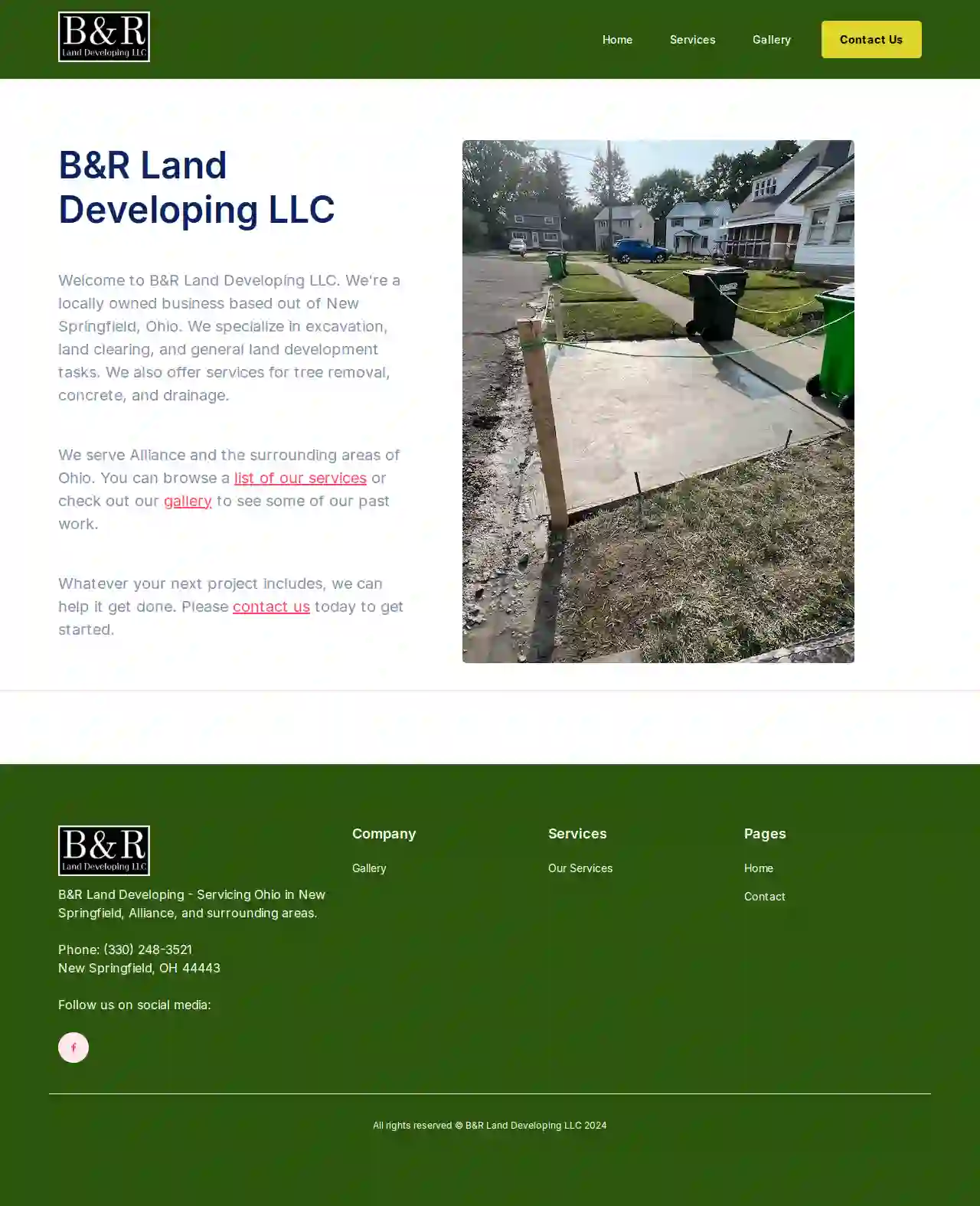
B&R Land Developing
53 reviewsNew SpringfieldOH, New Springfield, 44443, USWelcome to B&R Land Developing LLC We're a locally owned business based out of New Springfield, Ohio. We specialize in excavation, land clearing, and general land development tasks. We also offer services for tree removal, concrete, and drainage. We serve Alliance and the surrounding areas of Ohio. You can browse a list of our services or check out our gallery to see some of our past work. Whatever your next project includes, we can help it get done. Please contact us today to get started.
- Services
- Why Us?
- Gallery
Get Quote
JTR Lawn and Landscape LLC
535 reviewsYoungstown, USAbout JTR Lawn and Landscape LLC. At JTR Lawn and Landscape LLC, our mission is to create beautiful and functional outdoor spaces that enhance the lives of our clients. We believe that everyone deserves to have a stunning outdoor space that they can enjoy with family and friends. Our Services We offer a wide range of services to help you create the outdoor space of your dreams. From landscape design and installation to hardscaping and weekly lawn maintenance services, we have the expertise to bring your vision to life. Our Team Our team is made up of highly skilled and experienced professionals who are passionate about what they do. We are committed to providing our clients with exceptional service and ensuring that every project is completed to the highest standards.
- Services
- Why Us?
- Gallery
Get Quote
Over 22,076+ Excavation Contractors in our network
Our excavation contractors operate in Tallmadge and surrounding areas!
ExcavationHQ has curated and vetted the Best Excavation Contractors arround Tallmadge. Find the most reliable business today.
Frequently Asked Questions About Demolition Contractors
- Site Security: Secure the demolition site with fencing and warning signs to prevent unauthorized access.
- Personal Protective Equipment (PPE): Workers should wear appropriate PPE, including hard hats, safety glasses, gloves, and steel-toe boots.
- Hazardous Material Removal: Properly identify and remove asbestos, lead paint, or other hazardous materials before demolition begins.
- Utility Disconnections: Disconnect all utilities, such as electricity, gas, and water, before demolition.
- Controlled Demolition Techniques: Employ controlled demolition methods to minimize risks and ensure the structure comes down safely.
- Dust Control: Implement dust suppression measures, such as water spraying or misting, to reduce airborne particles and protect air quality.
- Emergency Planning: Have an emergency plan in place, including communication protocols and evacuation procedures, in case of unforeseen events.
- Project Assessment: The demolition contractor evaluates the structure, site conditions, and project requirements.
- Permitting: Obtain necessary demolition permits from local authorities.
- Site Preparation: Secure the site, disconnect utilities, and remove any valuable or reusable items.
- Hazardous Material Abatement: Professionally remove asbestos, lead paint, or other hazardous materials if present.
- Demolition: Execute the chosen demolition method, bringing down the structure safely and efficiently.
- Debris Removal and Site Cleanup: Sort, process, and dispose of demolition debris responsibly. Clean up the site to prepare it for future use.
- General Liability Insurance: Covers bodily injury or property damage to third parties caused by the contractor's negligence.
- Workers' Compensation Insurance: Provides benefits to workers injured on the job.
- Pollution Liability Insurance: Covers costs associated with environmental contamination caused by demolition activities.
- Professional Liability Insurance: Protects against claims of negligence or errors in professional services, such as demolition planning or consulting.
- Feasibility Studies: Assessing the viability and challenges of a demolition project.
- Demolition Planning: Developing demolition plans, including method selection, sequencing, and safety procedures.
- Permitting Assistance: Navigating the demolition permitting process and ensuring compliance with regulations.
- Hazardous Material Surveys: Identifying and managing hazardous materials, such as asbestos and lead paint.
- Cost Estimating: Providing accurate cost estimates for demolition services.
- Project Management: Overseeing the demolition process and ensuring it proceeds as planned.
What are the safety precautions for demolition?
What are the steps involved in a typical demolition process?
What is the importance of insurance in demolition projects?
What is the role of a demolition consultant?
What are the safety precautions for demolition?
- Site Security: Secure the demolition site with fencing and warning signs to prevent unauthorized access.
- Personal Protective Equipment (PPE): Workers should wear appropriate PPE, including hard hats, safety glasses, gloves, and steel-toe boots.
- Hazardous Material Removal: Properly identify and remove asbestos, lead paint, or other hazardous materials before demolition begins.
- Utility Disconnections: Disconnect all utilities, such as electricity, gas, and water, before demolition.
- Controlled Demolition Techniques: Employ controlled demolition methods to minimize risks and ensure the structure comes down safely.
- Dust Control: Implement dust suppression measures, such as water spraying or misting, to reduce airborne particles and protect air quality.
- Emergency Planning: Have an emergency plan in place, including communication protocols and evacuation procedures, in case of unforeseen events.
What are the steps involved in a typical demolition process?
- Project Assessment: The demolition contractor evaluates the structure, site conditions, and project requirements.
- Permitting: Obtain necessary demolition permits from local authorities.
- Site Preparation: Secure the site, disconnect utilities, and remove any valuable or reusable items.
- Hazardous Material Abatement: Professionally remove asbestos, lead paint, or other hazardous materials if present.
- Demolition: Execute the chosen demolition method, bringing down the structure safely and efficiently.
- Debris Removal and Site Cleanup: Sort, process, and dispose of demolition debris responsibly. Clean up the site to prepare it for future use.
What is the importance of insurance in demolition projects?
- General Liability Insurance: Covers bodily injury or property damage to third parties caused by the contractor's negligence.
- Workers' Compensation Insurance: Provides benefits to workers injured on the job.
- Pollution Liability Insurance: Covers costs associated with environmental contamination caused by demolition activities.
- Professional Liability Insurance: Protects against claims of negligence or errors in professional services, such as demolition planning or consulting.
What is the role of a demolition consultant?
- Feasibility Studies: Assessing the viability and challenges of a demolition project.
- Demolition Planning: Developing demolition plans, including method selection, sequencing, and safety procedures.
- Permitting Assistance: Navigating the demolition permitting process and ensuring compliance with regulations.
- Hazardous Material Surveys: Identifying and managing hazardous materials, such as asbestos and lead paint.
- Cost Estimating: Providing accurate cost estimates for demolition services.
- Project Management: Overseeing the demolition process and ensuring it proceeds as planned.